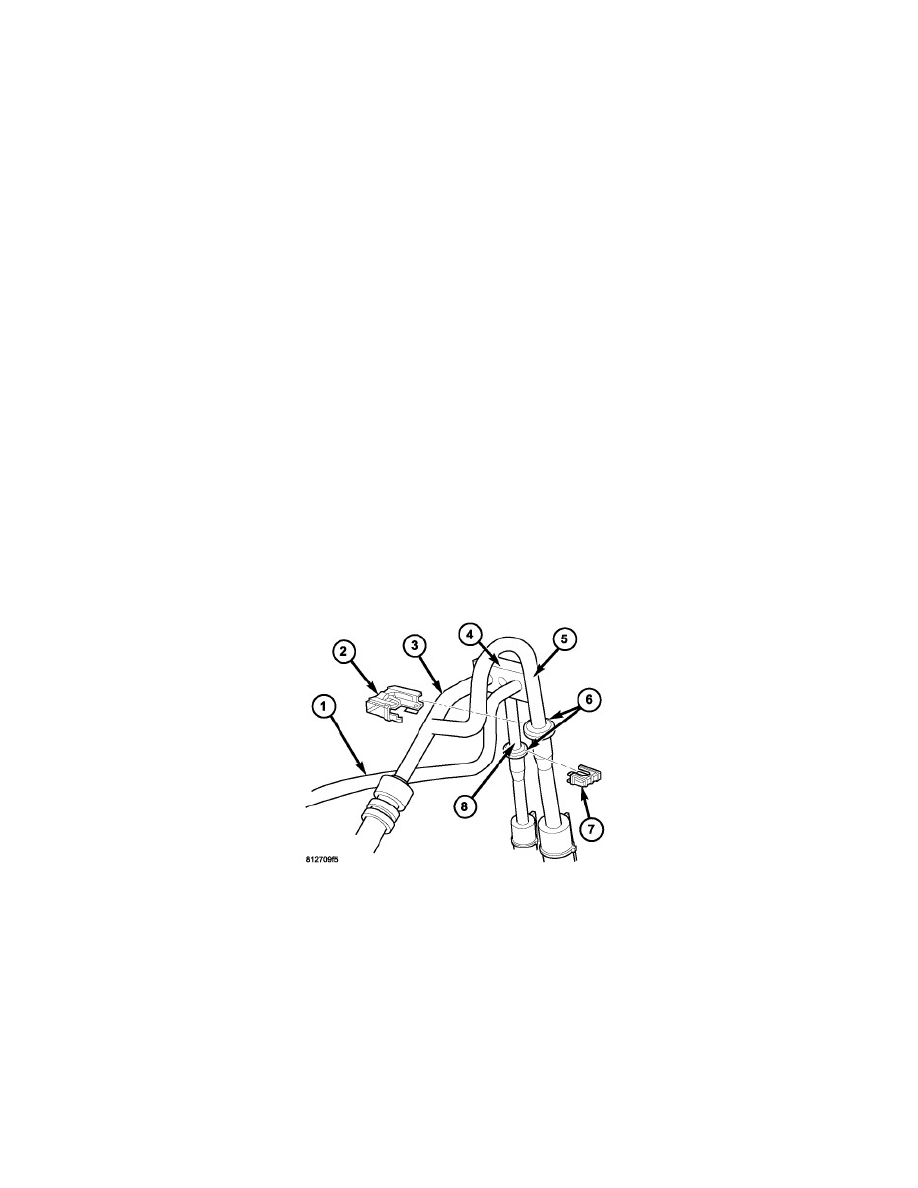Durango 2WD V6-3.7L (2009)

8. Remove the right front wheelhouse splash shield.
9. Remove the plastic retainer (1) that secures the A/C suction line (2) to the liquid line tapping block (4).
10. Remove the nut (3) that secures the liquid line tapping block to the A/C expansion valve (5).
11. Disconnect the A/C suction line and the rear section of the A/C liquid line from the A/C expansion valve and remove and discard the O-ring seals
and gaskets.
12. Install plugs in, or tape over, the opened refrigerant line fittings and the expansion valve ports.
13. Separate the A/C suction line from the liquid line tapping block.
14. On models equipped with the rear heating-A/C system, disconnect the underbody refrigerant line from the A/C suction line See: Heating and Air
Conditioning/Coupler HVAC/Service and Repair/Refrigerant Line Coupler - Removal and See: A/C Liquid Line - Removal.
15. Remove the A/C suction line from the engine compartment.
Rear
REMOVAL
WARNING: On vehicles equipped with the high voltage system, you must thoroughly read and follow all High Voltage Safety procedures. In
addition, before performing any diagnostic or service procedure near a high voltage component, you must perform the High
Voltage Power Down. Failure to follow these instructions may result in possible serious or fatal injury
WARNING: Refer to the applicable warnings and cautions for this system before performing the following operation See: Heating and Air
Conditioning/Service Precautions/Warning and See: Heating and Air Conditioning/Service Precautions/Caution . Failure to follow the
warnings and cautions may result in possible serious or fatal injury.
CAUTION: Polyalkylene Glycol (PAG) oil can contaminate the refrigerant system of a Hybrid Electric Vehicle (HEV) and lead to A/C system
damage and failure. If the refrigerant recovery/recycling and charging equipment was last used on a non-HEV model, flush the
hoses of the equipment with a solvent approved by the equipment manufacturer before using the equipment on an HEV model, or
use refrigerant recovery/recycling and charging equipment designated only for HEV models by your service facility. See the
operating instructions supplied by the equipment manufacturer for proper use and care of the refrigerant recovery/recycling and
charging equipment.
NOTE: The A/C suction line connects between the A/C evaporator and the A/C compressor. On models equipped with the rear heating-A/C
system, the A/C suction line also includes an extension tube that connects the suction line to the underbody lines.
1. On HEV models, disconnect the battery system using the service disconnect at the battery pack
2. On gasoline only engine models, disconnect and isolate the negative battery cable.
3. Recover the refrigerant from the refrigerant system See: Heating and Air Conditioning/Service and Repair/Refrigerant System Recovery.
4. Disconnect the A/C suction line (3) from the A/C compressor and the front A/C expansion valve See: A/C Suction Line - Removal
5. Remove the secondary retaining clip (2) from the refrigerant line coupler (6) on the suction line extension tube (5)
6. Disconnect the underbody suction line from the suction line extension tube using the proper A/C line disconnect tool (Special Tool Kit 7193 or
equivalent) and remove and discard the O-ring seal See: Heating and Air Conditioning/Coupler HVAC/Service and Repair/Refrigerant Line
Coupler - Removal.
7. Install plugs in, or tape over the refrigerant line coupler and the underbody suction line.
8. Remove the A/C suction line from the engine compartment.
Front
3.7L/4.7L ENGINES
